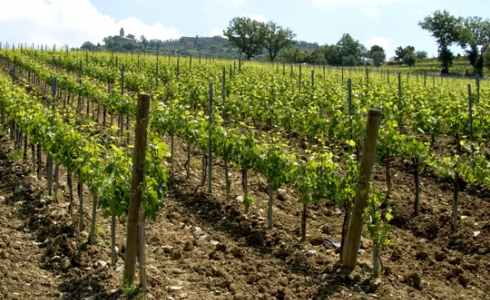



Wine: Red wine
Taste: Dry
Volume: Strong
Min. alcohol: 12.5%
Mandatory Storage: Min. 2 years
Storage potential: 7 years
Already in the 1700s, people were breaking out the superlatives to describe Vino Nobile di Montepulciano. Writer and poet Francesco Redi went so far as to call it "The King of all Wines", and at that time the wine was also the most sought after in all of Tuscany. The term, ’Nobile’, can be seen on many copper plates from the mid-1700s, and refers to the fact that the wine ranked above the base wine from the city.
The writer’s enthusiasm notwithstanding, Vino Nobile di Montepulciano had a hard time, and from the mid-1800s until the start of the 1900s, it disappeared into oblivion. Around the 1920s, some enthusiasts began to work on a relaunch, and with great dedication, they succeeded in recapturing success in the early 1930s, where a number of serious producers hopped on the Vino Nobile bandwagon. International recognition followed shortly thereafter.
Then followed another downturn in the beginning of the 1970s, where the quality was quite poor. Among other things, the regulations allowed for producers to obtain grapes/must from Southern Italy, and up to 38% green grapes could be used in a ”red” wine. The result was best suited, according to some opinions, as carburetor juice.
Over the past few decades, there have been a number of positive developments, and the wine can again be ranked among Italy’s top wines.
Vino Nobile di Montepulciano is cultivated on 820 to 1969 feet tall hills around the medieval city of Montepulciano, in the southeastern part of Tuscany, where there are ideal growing conditions. The hills, which slope down towards the city, Chiana, have exactly the right soil composition and climate needed.
Vino Nobile is in the same family as Chianti Classico and Brunello di Montalcino, in that it is primarily made from the Prugnulo Gentile grape, a local Sangiovese type (70-100%). The wine is often in a class of its own, partly due to the aforementioned climate and soil, but also due to the presence of the Canaiolo grape (0-10%), along with local red grapes (0-20%, on the condition that there is a maximum 10% of the green Malvasia del Chianti grape).
Canaiolo is used by several top producers, because of its ability to calm the primary grape’s power. Additionally, Mammolo is often added, which provides the well-known hints of violet.
Vino Nobile di Montepulciano became a DOC in 1966, and a DOCG in 1980, where we also see the most significant elevation in quality. An intense and serious effort by a new generation of wine producers ensured a rapid and positive development that is still ongoing. Though Vino Nobile isn’t in the same league as the Barolo, Brunello and Bolgheri wines, it is in the league just under. And when made by the best producers, it’s a world-class wine.
The color is ruby red, with a tendency towards garnet with age. The aroma is intense, ethereal and characteristic. The taste is dry, balanced and nicely persistent, with hints of wood. The minimum alcohol concentration is 12.5%.
Despite its close kinship to Brunello di Montepulciano, it doesn’t require anywhere near as much time before it peaks. Under normal circumstances, the wine can be consumed within 4-7 years, often after 10 years or more. The same is true for Vino Nobile di Montepulciano Riserva, which needs to age longer and has a minimum 13% alcohol concentration.
Vino Nobile has a little brother with the same grape composition, Rosso di Montepulciano. The aging requirements are a bit lower and the harvest yield larger, thus resulting in a lower price. It’s an interesting wine to start with, if you want to slowly sneak up on Vino Nobile.
Mandatory aging: 2 years calculated from January 1 after the harvest year. Must age in oak or chestnut barrels; Reserve 3 years, of which 6 months in the bottle.
Shelf life: 4-7 years. Some vintages 10 years or more
Italy extends over 10 latitudes – from continental climate to subtropical climate?